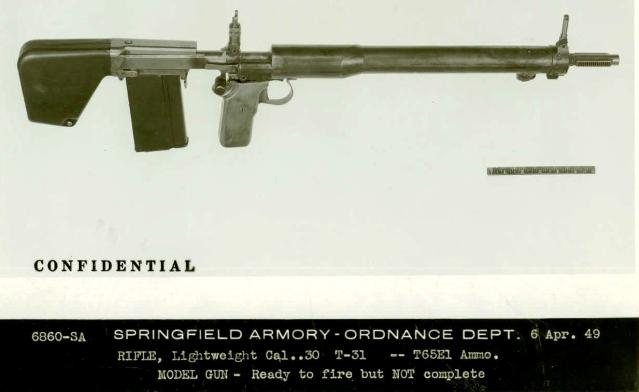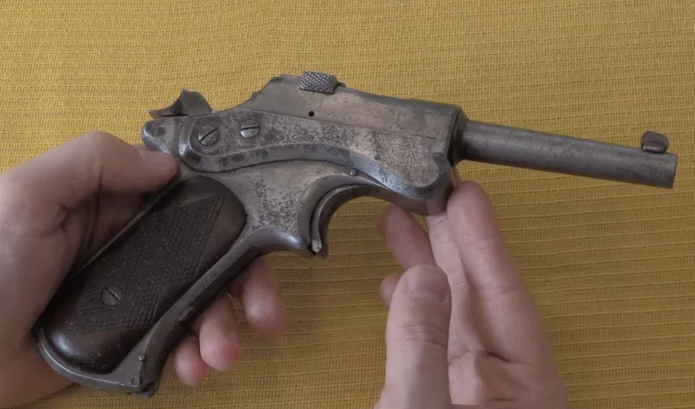The light rifle program was instituted in late 1945 to develop a new infantry rifle using the T65 cartridge (which would go on to be adopted as the 7.62x51mm NATO-standard). Initially the project involved just the T25 rifle developed by Earle Harvey, but in 1946 John Garand and Cyril Moore joined to program, each with their own distinctive designs. The plan was for all three guns to compete and the best one of the batch to continue to full development.
Garand’s entry was by far the most innovative and unorthodox, and yet reflected back to his work on the M1 rifle at the same time. The project requirement was for a 7-pound rifle, so Garand chose to use a bullpup layout to maximize barrel length at a minimum of weight (although the T31 ended up weighing in at 8.7 pounds). The operating system he developed for the rifle harkened back to the gas trap idea used on the early production M1 rifles. The entire barrel was surrounded by a sealed cylinder, and the muzzle was located slightly back inside this cylinder. When fired, some of the expanding gas at the muzzle would bounce back into the cylinder, creating a shock wave traveling down its length. At the back end of the cylinder was a short-stroke tappet type piston which would transmit the force of the gas into the bolt, cycling the action.

This system was intended to do several beneficial things. First, it would function based on the exit pressure at the muzzle, and not depend on having a particular pressure curve as the bullet moved down the barrel (changes in pressure curves with new ammunition caused the demise of Garand’s first primer-actuated rifle design). Second, it would absolutely delay the action from unlocking until after the bullet had left, thus ensuring safe pressure when extracting spent cases. Finally, the redirecting of much of the muzzle blast would attenuate the concussion of firing, and recoil as well to some extent.
According to several descriptions, the handguard of the rifle also incorporated an open jacket much like a Lewis gun jacket. A slight vacuum caused by the muzzle blast would pull cool air through this sleeve from the rear of the rifle, thus preventing the handguard and gas cylinder from overheating. Exactly how this open sleeve and the gas cylinder were built into the front end of the rifle is not particularly clear from the photos available.
The method of locking is not clear, but the action is described as being completely closed, with the ejection port opening only as the bolt cycled. The rifle had a select-fire trigger group, and fed from a 20-round magazine of Garand’s design. This magazine would prove to be the only element of the T31 to see use, as it was used in the T44 rifle (which eventually became the M14). Only a very small number of T31 prototypes were built, possibly as few as just two.
The T31, for all its innovations, was an experimental rifle that had its fair share of problems to work out. Most significantly, the very large volume of the gas cylinder allowed the muzzle gases a great amount of time and space to cool and deposit carbon. Reportedly after a 2,000-round endurance test of the rifle more than a pound of carbon was scraped out of the gas cylinder. This is not surprising (well, the sheer mass might be, but not the fundamental problem), as it is the same issue that proved to be the Achilles’ heel of all the other gas-trap rifles ever made, like the German G41(M) and G41(W) and Garand’s own first production M1 design. Fouling builds up quickly, and renders the rifle unreliable.
Our understanding is that in light of this problem, Garand was in the process of designing a second model of the T31 using a more conventional gas piston system when he retired from Springfield Armory employ in 1953. He would continue to do intermittent consulting work with the Armory, but the T31 project ended with his departure.
Ultimately, the T31 was too radical in appearance to be considered for military use by the very conservative military bureaucracy in the post-WWII era, even without taking its functional problems into account. Garand had made an audacious attempt to tackle the problems of muzzle blast and recoil in a .30-caliber light rifle, but the administrative willpower did not exist to support virtually anything beyond a product-improved M1 at the time (as evidenced by the termination of the much-more-conventional T25).
Technical Data:
Caliber: 0.30
Cartridge: T65 (eventually to become the 7.62 x 51mm)
Weight, unloaded: 8.7 lb
Magazine capacity: 20 rounds
Overall length: 33.4 in
Barrel length (including muzzle brake): 24 in
Cyclic rate: 600 rpm
Locking method: unknown; probably rotating bolt
Operating method: Gas trap with tappet piston



Really interesting desciption of yet another truly forgotten weapon — thanks, Ian. I wonder what the trigger pull on the T31 prototype was like, and if Garand had designed a particular linkage system to at least partially alleviate the typical wooden trigger feel of a bullpup.
Thanks for the post Ian. I hope its OK – I’ve copied the link to here and posted in the CMP Forum. Its begun to generate discussion there among those who have Garanditis. Here’s the link but to post you need to belong. http://forums.thecmp.org/showthread.php?p=779547#post779547
Thermodynamics dictate that if you expand and cool a high pressure gas containing a solute, the solute will precipitate out. This is why these expansion chamber gas systems foul themselves with carbon, which is an inevitable solute in propellant gases. John Garand’s T31 was probably also contending with plastic fouling due to the T65 cartridge being designed around the ten new ball powder.
Virtually all smokeless propellants are liberally coated with carbon to prevent static electrical discharges, which can cause unintended ignition. Ball powders are agglomerated with colloidal plastic binders. There is not enough oxygen in the combustion process to gasify these constituents, so they go into solution in the propellant gas as chamber pressures rise.
The ball powder plastic binders codeposit with the carbon when the gas expands and cools, leaving a very difficult to remove layer of polyethelene bonded crud. This was the reason that the M16 rifle developed a poor reputation for reliability when ball propellants were first used in U.S. M193 5.56mm ammunition. The M16 was developed around 5.56mm cartridges which used IMR 8208 stick powder, a particularly clean buring stick powder devoid of plastic. Similarly, Garand developed his M1 rifle around .30 M2 cartridges loaded with IMR 4895 powder, another clean burning powder. He might not have understood the fouling consequences of the new ball powder used in the T65 cartridge.
This tendency to precipitate out solutes also plagues silencer designers. The answer may lie in the hands of smokeless powder chemists. Metalloid antistatic compounds exist which might provide performance superior to the much cheaper carbon antistatic coating used today.
Word.
The T25 link at the bottom of the last paragraph is broken. Here are some similar pages.
https://www.forgottenweapons.com/m14-development/t25/
https://www.forgottenweapons.com/t25-rifle-report/
https://www.forgottenweapons.com/photos-of-1950s-light-rifle-prototypes/springfield-t25/
If you are ever in Cheyenne Wyoming and would like to fire my century arms 45 70 please let me know